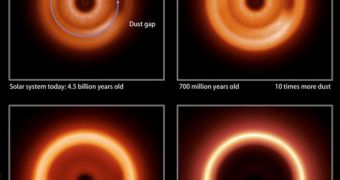A computer model has revealed that extraterrestrial civilizations may figure out we are in this solar system by looking at the dust ring that surrounds the Sun, planets, moons, and everything in between.
For alien observers living outside of the solar system, discovering holes in this dust belt would be a clear indicator that at least a planet exists around our yellow dwarf star.
In addition to showing us some new and interesting possibilities, the investigation could also allow scientists to become more efficient in discovering extrasolar planets orbiting other stars.
“We’re trying to create a new planet search technique, and we’re practicing on the solar system,” explains expert Marc Kuchner.
He holds an appointment as an exoplanet scientists at the American space agency, and is also the lead author of a new paper detailing the findings.
The work is published in the September 7 issue of the esteemed Astrophysical Journal, Wired reports.
“This field of studying shapes of debris disks has been around for a while, but it’s been qualitative. We’re trying to make it quantitative,” the expert says.
“We want to get to where you can give us a picture of a debris disk, and we can say bam – here are the planets, and here’s how massive they are,” he goes on to say.
The scientist and his team conducted their work on the Kuiper Belt, which is a wide swath of space containing small and icy particles, and occasionally larger rocks.
It lies beyond the orbit of Neptune, and is better known as the home of numerous comets, asteroids and dwarf planets, including Pluto, Haumea, Makemake and Eris.
The way dust particles move is not random, as one would be tempted to think at first. The Sun, the large gas giants, and other gravitational fields influence the ring and dictate its behavior.
Together with colleague Christopher Stark, who is based at the University of Maryland, Kuchner developed a computer model that keeps track of how the vast number of icy particles collide.
“You have something like a billion billion million particles, and they’re all hitting each other. Nobody before had figured out how to keep track of all that stuff,” the expert says.
“When you have low dust levels, like in today’s solar system, dust moves into resonances and makes a gap, which tells you where Neptune is,” he adds, saying that alien observers would have no difficulty in figuring this out.

 14 DAY TRIAL //
14 DAY TRIAL //